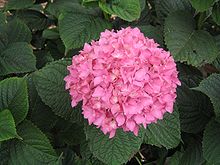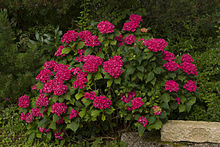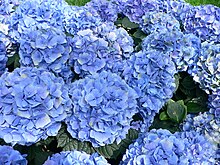Garden hydrangea
| Garden hydrangea | ||||||||||||
|---|---|---|---|---|---|---|---|---|---|---|---|---|

Garden hydrangea ( Hydrangea macrophylla ) |
||||||||||||
| Systematics | ||||||||||||
|
||||||||||||
| Scientific name | ||||||||||||
| Hydrangea macrophylla | ||||||||||||
| ( Thunb. ) Ser. |
The garden hydrangea ( Hydrangea macrophylla ) is a species of plant from the genus hydrangeas ( Hydrangea ) within the hydrangea family (Hydrangeaceae). The wild forms come from Japan . Many varieties are used as an ornamental plant. The umbrella-shaped inflorescences, the display apparatus of which is formed by sterile flowers with large, colored sepals , are characteristic.
Description of the wild form
The wild form of Hydrangea macrophylla is a deciduous subshrub whose old branches are lignified and the new ones are herbaceous . It can reach heights of up to 2 meters, outside of Japan even more.
The opposite leaves are divided into petiole and leaf blade. The simple leaf blade is oval to ovate with a length of up to 15 centimeters, wider or narrower depending on the variety. There are recognizable side ribs on each side of the midrib. The base of the spread is bluntly wedge-shaped, the leaf margin sharply serrated. The front of the sheet is drawn out into a point.
The inflorescences are zymous umbrella clusters with thick branches. The outer, sterile flowers have four 1 to 2.5 centimeters wide, egg-shaped to rounded sepals , which also form the display apparatus . Their color fluctuates between pure white or, depending on the pH value of the soil, between bluish in acidic and reddish in alkaline soils, whereby the color strength can be different. The inner, fertile flowers have a small, bell-shaped calyx with short triangular tips. The flowering period in Japan is from June to August.
Round-oval capsule fruits are formed.
The number of chromosomes is 2n = 36.
Use as an ornamental shrub

“Nowadays” the name garden hydrangea includes not only varieties of the species Hydrangea macrophylla , but also many varieties that presumably go back to crossings , especially with the velvet hydrangea ( Hydrangea aspera ).
Botanical and Horticultural History
The garden hydrangea has been cultivated in Japan for several centuries. It was first published in 1784 as Viburnum macrophyllum by Carl Peter Thunberg , who was then a doctor on the Deshima peninsula near Nagasaki .
Around 1790, the first plant specimens reached Europe, presumably via detours. When it comes to who and when exactly, you will find various information. Presumably it was Thunberg or the English botanist Joseph Banks who brought the plant with him. In any case, the cultivars that arose in Europe seem to go back to the plants that Banks brought to London, which were initially referred to as Hydrangea hortensis or Hydrangea hortensia (ancient Greek ὕδωρ hydōr , German ` ` water '' ) because of their high water requirements . The name hydrangea, Latin hortensis , comes from the name of the daughter of the Prince of Nassau, a participant in the Bougainville expedition, Hortense de Nassau. At first, the cultivation of the species was essentially restricted to botanical gardens . It was not until the end of the 19th century, and especially in the 20th century, that this plant species became popular in Europe, and several hundred new varieties were bred , especially in Belgium , Holland and France . Later these varieties came back to Japan, where they are called Seiyō Ajisai ( Japanese 西洋 紫陽 花 , Western hydrangea ' ).
Nowadays the garden hydrangea is planted in all areas with temperate to warm temperate climates with not too harsh winters. It thrives particularly well in higher humidity. In the Azores, for example, hydrangea hedges around gardens and fields and roadside planting made up of rows of hydrangeas are trademarks.
The flowers are blue in color
The flower blossoms of the garden hydrangea contain the dye delphinidin , an anthocyanin dye , the color of which depends on the pH of the solution : violet in acidic solution and red in alkaline solution . The flower color of the garden hydrangea depends on the pH value of the soil , although the exact values are different for the individual varieties. Typically a pH value between 4 and 4.5 results in violet flowers, with higher pH values the flower color changes from pink to red. However, white varieties do not change their flower color. For a pure blue color you also need aluminum ions in the soil. In addition, these dyes can change their color when combined with metal ions. The hydrangea has a particularly intense blue color due to aluminum ions . In practice, aluminum sulfate or alum are usually used to regulate the pH value . In soils that are not too acidic, however, the aluminum is already bound in the soil and does not turn blue.
maintenance
Garden hydrangeas are only partially hardy , depending on the variety . In harsh winters they can freeze back a lot, newly planted specimens can also die completely. Wintering in the house is possible, whereby the temperature should be just above 0 ° C.
The flowers of the garden hydrangea are created in the buds for the next year in late summer or early autumn at temperatures of around 15 ° C. The main flowering time is from June to August. This year's shoots are already bearing the flowers for the following year; therefore garden hydrangeas should not be cut back in autumn if they are to bloom in the next year. Another consequence is that late frosts can destroy the flower roots.
They prefer acidic, moist soils without waterlogging in a partially shaded location, but they also grow in neutral or slightly alkaline soil if one does without blue flower colors. In order not to increase the pH value of the soil, it should not be watered with calcareous tap water, but rather with rainwater, as the plant specimens otherwise tend to chlorosis , which leads to yellowing from the edge to the fall of the leaves.
The increase is almost always via head cuttings that are taken in the spring to early summer.
Varieties, distribution and locations
- Hydrangea macrophylla var. Normalis E.H.Wilson (Japanese Gaku-Ajisai , sepal hydrangea ' ): A variety that occurs in the warmer parts of Honshūs and Kyūshūs near the sea. Up to 2 meters high, with 5–15 centimeters long, broadly ovate, thick, glossy leaves. The color of the show flowers is pale blue, pale purple, or white.
- Hydrangea macrophylla var. Megacarpa (Japanese Ezo-Ajisai ' Hokkaidō hydrangea' ): A 1–1.5 meter high variety with 10–17 centimeters long, broadly egg-shaped leaves. The leaf margin is sharp, but quite roughly serrated. The long-stalked show flowers are brilliantly shining blue-purple, sometimes white-red. The variety is found in the mountains on the coasts of the Sea of Japan on Hokkaido, in the northern part of Honshū and on Kyushu.
- Hydrangea macrophylla var. Acuminata (Japanese Yama-ajisai , 'mountain hydrangea' ): This variety, which occurs in damp valleys and forests, becomes 1–1.5 meters high and 7–12 centimeters long, elongated, oval, shiny, thick, in a long point of drawn out leaves. The whitish-purple flowers have a long stem. The flowering period is from June to August. It occurs on Honshū, Shikoku , Kyushu and in South Korea .
- Hydrangea macrophylla var. Thunbergii (Japanese 甘 茶 Amacha , German 'sweet tea' ): Similar to var. Acuminata , but only 0.7–1 meters high in the wild and has mostly reddish overflowing, 5–10 cm long leaves. The leaves turn sweet when you dry them. They are used as tea or sweetener for tea at the Japanese Flower Festival ( Hana-Matsuri ). It is for this reason that the variety is cultivated.
- Hydrangea macrophylla var. Oamacha (Japanese 大 甘 茶 Ōamacha , German 'Big Sweet Tea' ): The twigs are slightly thicker than those of the var. Thunbergii . The somewhat larger and wider leaves are also mostly reddish. The sepals of the show flowers are blue-purple and rounded. This variety is also used as a tea, sweetener or as a medicinal plant.
- Hydrangea macrophylla var. Amagiana (Japanese 天 城 甘 茶 Amagi-Amacha , German “ Amagi sweet tea” ): Similar to Hydrangea macrophylla var. Acuminata , but leaves 5–10 centimeters long, lanceolate. The show flowers, which consist of four to five egg-shaped sepals, are rather small and pure white. The flowering period is from June to August. This variety occurs wild in the mountains of the Izu Peninsula on Honshū. But it is cultivated because its leaves can also be used as tea, sweetener or medicine.
- Hydrangea macrophylla var. Macrophylla : This variety includes all varieties with only sterile flowers. It is usually up to 1.5 meters high, has 10-15 centimeters long, ovate to broadly ovate, thick and shiny leaves. The flowering period is from June to July.
Sometimes the species Hydrangea serrata is also considered a variety or subspecies of Hydrangea macrophylla .
swell
Individual evidence
- ^ Erich Oberdorfer : Plant-sociological excursion flora for Germany and neighboring areas . 8th edition. Verlag Eugen Ulmer, Stuttgart 2001, ISBN 3-8001-3131-5 . Page 493–494.
- ↑ cf. z. B. www.kamelienschloss.de: Hydrangeas ( Memento of the original from August 18, 2007 in the Internet Archive ) Info: The archive link was inserted automatically and has not yet been checked. Please check the original and archive link according to the instructions and then remove this notice.
- ↑ www.gartentechnik.de: Farmer's hydrangeas and perennial phlox
- ↑ Botany of the hydrangeas
- ↑ a b c d e f Chamber of Agriculture: When are garden hydrangeas cut?
- ↑ The flower color of blue hydrangeas. Chemistry / Uni Bayreuth, February 3, 2005.
- ↑ Bild am Sonntag: Cut hydrangeas now ... so that they bloom next summer
- ↑ www.gartenfreunde.de: Do not cut back garden hydrangeas in winter
- ↑ www.hortensien.net: Frequently asked questions about caring for hydrangeas
- ↑ PflanzenTanzen.de : Hydrangea propagation
literature
- Gordon Cheers (Ed.): Botanica . Random House Australia 2003. German edition: Tandem Verlag GmbH 2003, ISBN 3-8331-1600-5 .
- Urania plant kingdom . Volume 3: Flowering Plants 1, 1st edition. Urania-Verlag, Leipzig 1991, ISBN 3-332-00367-4 .
- Hayashi Yasaka: Nihon-no Jumoku. Yama to Keikoku Sha, Tokyo 1985, ISBN 4-635-09017-5 .


